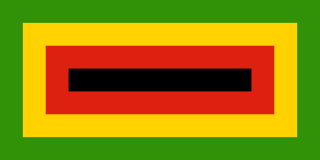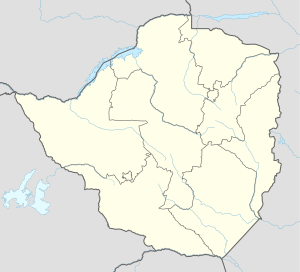
Rhodesia, officially from 1970 the Republic of Rhodesia, was an unrecognised state in Southern Africa from 1965 to 1979, equivalent in territory to modern Zimbabwe. Rhodesia was the de facto successor state to the British colony of Southern Rhodesia, which had been self-governing since achieving responsible government in 1923. A landlocked nation, Rhodesia was bordered by South Africa to the south, Bechuanaland to the southwest, Zambia to the northwest, and Mozambique to the east. From 1965 to 1979, Rhodesia was one of two independent states on the African continent governed by a white minority of European descent and culture, the other being South Africa.

The Zimbabwe African National Union (ZANU) was a militant socialist organisation that fought against white-minority rule in Rhodesia, formed as a split from the Zimbabwe African People's Union (ZAPU) in 1963. ZANU split in 1975 into wings loyal to Robert Mugabe and Ndabaningi Sithole, later respectively called ZANU–PF and ZANU–Ndonga. These two sub-divisions ran separately at the 1980 general election, where ZANU–PF has been in power ever since, and ZANU–Ndonga a minor opposition party.

The Rhodesian Bush War, also called the Second Chimurenga as well as the Zimbabwean War of Liberation, was a civil conflict from July 1964 to December 1979 in the unrecognised country of Rhodesia.

The Rhodesian African Rifles (RAR) was a regiment of the Rhodesian Army. The ranks of the RAR were recruited from the black African population, although officers were generally from the white population. The regiment was formed in May 1940 in the British colony of Southern Rhodesia.

Zimbabwe African National Liberation Army (ZANLA) was the military wing of the Zimbabwe African National Union (ZANU), a militant African nationalist organisation that participated in the Rhodesian Bush War against white minority rule of Rhodesia.

The military history of Zimbabwe chronicles a vast time period and complex events from the dawn of history until the present time. It covers invasions of native peoples of Africa, encroachment by Europeans, and civil conflict.

Air Rhodesia Flight 825 was a scheduled passenger flight that was shot down by the Zimbabwe People's Revolutionary Army (ZIPRA) on 3 September 1978, during the Rhodesian Bush War. The aircraft involved, a Vickers Viscount named the Hunyani, was flying the last leg of Air Rhodesia's regular scheduled service from Victoria Falls to the capital Salisbury, via the resort town of Kariba.

The 1st Battalion, The Rhodesian Light Infantry, commonly the Rhodesian Light Infantry, was originally formed in 1961 as a regiment of the army of the Federation of Rhodesia and Nyasaland. Raised as a light infantry unit at Brady Barracks, Bulawayo in Southern Rhodesia, the Regiment served in the Rhodesian Bush War as part of the Rhodesian Security Forces between 1964 and 1979, from 1965 under the unrecognised governments of Rhodesia and latterly, during the second half of 1979, Zimbabwe Rhodesia. The RLI remained active during an interim period under British control and then, from April 1980, within the armed forces of Zimbabwe, before disbanding on 31 October 1980.

The 1st Battalion, The Rhodesian Light Infantry, commonly the Rhodesian Light Infantry, served in the Rhodesian Bush War as part of the Rhodesian Security Forces between 1964 and 1979, under the unrecognised government of Rhodesia following its 1965 Unilateral Declaration of Independence from Britain. During the second half of 1979 it fought for Zimbabwe Rhodesia, a black majority-ruled version of the same state which also failed to win international recognition. After an interim period under British control from December 1979 to April 1980, the RLI briefly remained active within the armed forces of Zimbabwe, but did not see action under this government. It disbanded on 31 October 1980.
The 1st Battalion, The Rhodesian Light Infantry, commonly the Rhodesian Light Infantry, served in the Rhodesian Bush War as part of the Rhodesian Security Forces between 1964 and 1979, under the unrecognised government of Rhodesia after its Unilateral Declaration of Independence from Britain on 11 November 1965. Latterly, during the second half of 1979, it fought for Zimbabwe Rhodesia, a reorganised version of Rhodesia under a black majority government which still went unrecognised. After an interim period under British control from December 1979 to April 1980, the RLI briefly remained active within the armed forces of the internationally recognised Republic of Zimbabwe, but did not see action under this government. It laid up its colours on 17 October 1980 and disbanded two weeks later.

The Geneva Conference took place in Geneva, Switzerland during the Rhodesian Bush War. Held under British mediation, its participants were the unrecognised government of Rhodesia, led by Ian Smith, and a number of rival Rhodesian black nationalist parties: the African National Council, led by Bishop Abel Muzorewa; the Front for the Liberation of Zimbabwe, led by James Chikerema; and a joint "Patriotic Front" made up of Robert Mugabe's Zimbabwe African National Union and the Zimbabwe African People's Union led by Joshua Nkomo. The purpose of the conference was to attempt to agree on a new constitution for Rhodesia and in doing so find a way to end the Bush War raging between the government and the guerrillas commanded by Mugabe and Nkomo respectively.

The Victoria Falls Conference took place on 26 August 1975 aboard a South African Railways train halfway across the Victoria Falls Bridge on the border between the unrecognised state of Rhodesia and Zambia. It was the culmination of the "détente" policy introduced and championed by B. J. Vorster, the Prime Minister of South Africa, which was then under apartheid and was attempting to improve its relations with the Frontline States to Rhodesia's north, west and east by helping to produce a settlement in Rhodesia. The participants in the conference were a delegation led by the Rhodesian Prime Minister Ian Smith on behalf of his government, and a nationalist delegation attending under the banner of Abel Muzorewa's African National Council (UANC), which for this conference also incorporated delegates from the Zimbabwe African National Union (ZANU), the Zimbabwe African People's Union (ZAPU) and the Front for the Liberation of Zimbabwe (FROLIZI). Vorster and the Zambian President Kenneth Kaunda acted as mediators in the conference, which was held on the border in an attempt to provide a venue both sides would accept as neutral.

7 Independent Company was a short-lived company of francophone volunteers in the Rhodesian Army during the Rhodesian Bush War. Numbering about 200 men at its peak, it was unique in the history of the Rhodesian Army as an exclusively expatriate unit. It existed between November 1977 and May 1978 as a company in the 1st Battalion, the Rhodesia Regiment, and served two counter-insurgency tours on Operation Hurricane in north-eastern Rhodesia.
The 1981 Entumbane uprising, also known as the Battle of Bulawayo or Entumbane II, occurred between 8 and 12 February 1981 in and around Bulawayo, Zimbabwe amid political tensions in the newly independent state. Zimbabwe People's Revolutionary Army (ZIPRA) guerrillas, mainly in the city's western suburb of Entumbane, rebelled, creating a situation that threatened to develop into a fresh civil war, barely a year after the end of the Bush War. The Rhodesian African Rifles (RAR) and other white-commanded elements of the former Rhodesian Security Forces, fighting for the Zimbabwean government as part of the new Zimbabwe National Army, put down the uprising. Groups of Zimbabwe African National Liberation Army (ZANLA) fighters attacked both ZIPRA and the government forces during the revolt, which followed a smaller outbreak of fighting between guerrillas in November 1980.
The attack on Altena Farm occurred in the early hours of 21 December 1972, during the third phase of the Rhodesian Bush War. Altena was a tobacco farm owned by Marc de Borchgrave, a white Rhodesian landowner who was unpopular among the local civilians. Some sources have indicated that this marked the beginning of the conflict proper, despite the minor threat already represented by guerrilla movements in Rhodesia in the late 1960s.
Operation Flotilla was a military operation launched by the Rhodesian Army working with the Portuguese Army in Mozambique in response to the threat posed to Rhodesia by a group of 17 Lusaka-based nationalists who had the intent of entering Rhodesia through its border with Mozambique.
Operation Nickel or the Wankie Campaign or the Wankie Battles was a military operation launched by the Rhodesian Security Forces on 1 August 1967 in response to the group of ZIPRA and Umkhonto we Sizwe (MK) fighters crossing the Zambezi River, which marked the Rhodesian-Zambian border. The operation was a success with only one of the cadres out of a force of seventy-nine making it back to Zambia.
Late on 22 December 1972, a troop from the Rhodesian Special Air Service, followed shortly by the Rhodesian Light Infantry, reported to the police station in Centenary. The land mine in Altena's driveway was discovered, disarmed and removed. For their own safety, Marc de Borchgrave and his family were sent to Whistlefield Farm, which was owned by Archie Dalgluish and his family, while their family home was being repaired.
The Oberholzer murder occurred in Rhodesia on 4 July 1964, when members of the Zimbabwe African National Union (ZANU) attacked and killed Pieter Johan Andries (Andrew) Oberholzer, who worked as a foreman of the Silverstreams Wattle Company.

The Police Anti-Terrorist Unit (PATU) was a paramilitary auxiliary arm of the British South Africa Police (BSAP) in Rhodesia. The unit was founded in 1966. The concept was created for guerrilla bush warfare and the personnel were both black and white policemen. The unit was abolished in 1980 following the dissolution of the BSAP.












